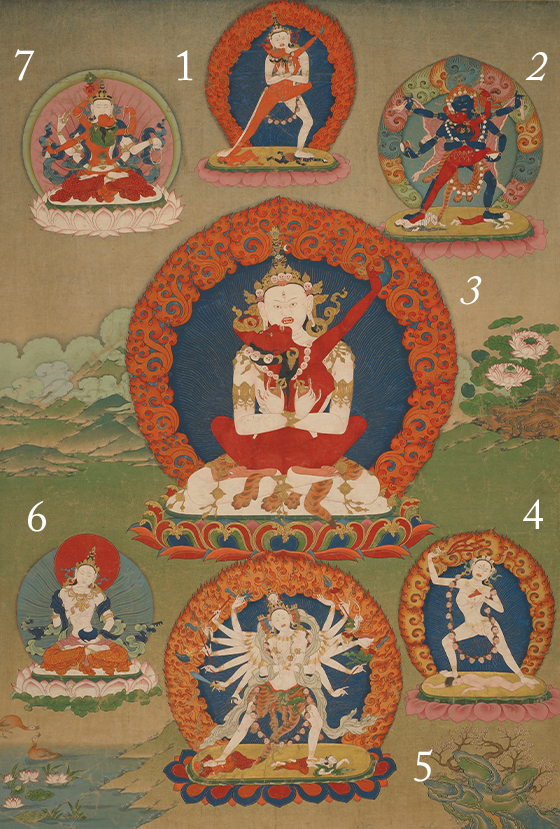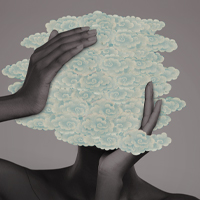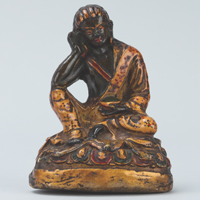
Overcoming attachment through focus on mastering bliss
As explained in Tibetan commentaries, practices focused on the tantric deity Chakrasamvara and his consort Vajrayogini are means of overcoming attachment, desire, and the ignorance of not realizing the true nature of reality, which is the emptiness of all phenomena. These mental afflictions are among the fundamental causes of the endless cycle of birth, death, and rebirth known as samsara. The central deities in this painting are in sexual embrace, a symbolic representation of secret tantric teachings on the union of wisdom and method necessary for achieving full awakening. In tantra, this state of awareness is also known as the supreme bliss.
The name Chakrasamvara in Sanskrit means Circle (chakra) of Gathered Together Deities (samvara) in reference to the deities representing all aspects of body, speech, and mind required for a practitioner’s nonconceptual realization of emptiness through experiences of subtle bliss. Tibetan translations of the name clarify its meaning, emphasizing bliss and pleasure and forming the name Demchok (bde mchog), meaning Supreme Bliss.

Chakrasamvara practices are meant for the initiated to help cultivate and experience the stages of bliss that enable them to attain the subtlest level of mind, or pure awareness known as the clear light. With this awareness they are able to gain insight into the meaning of emptiness and eventually become a buddha.
This painting’s well-recorded composition presents a group of deities that are neither part of the mandala of Chakrasamvara nor belong to the same practice, but they are loosely grouped as they all relate to practices for extending life. Prolonging lifespan is not the ultimate objective of long-life practices, but it is considered a helpful condition that allows more time to work toward the goal of awakening.
See this painting in the exhibition Masterworks: A Journey through Himalayan Art at the Rubin Museum of Art through October 6, 2024.
About the Contributor
Elena Pakhoutova is a senior curator of Himalayan art at the Rubin Museum of Art and holds a PhD in Asian art history from the University of Virginia. She has curated several exhibitions at the Rubin, most recently Death Is Not the End (2023), The Power of Intention: Reinventing the (Prayer) Wheel (2019), and The Second Buddha: Master of Time (2018).
Image Credit
White Chakrasamvara with Consort, and Six Deities; from The Twenty-seven Tantric Deities series designed and commissioned by Situ Panchen (1700–1774) from Tsewang Drakpa of Jeto; Kham region, eastern Tibet; ca. 18th century; pigments on cloth; Rubin Museum of Art; C2006.66.15 (HAR 432)





